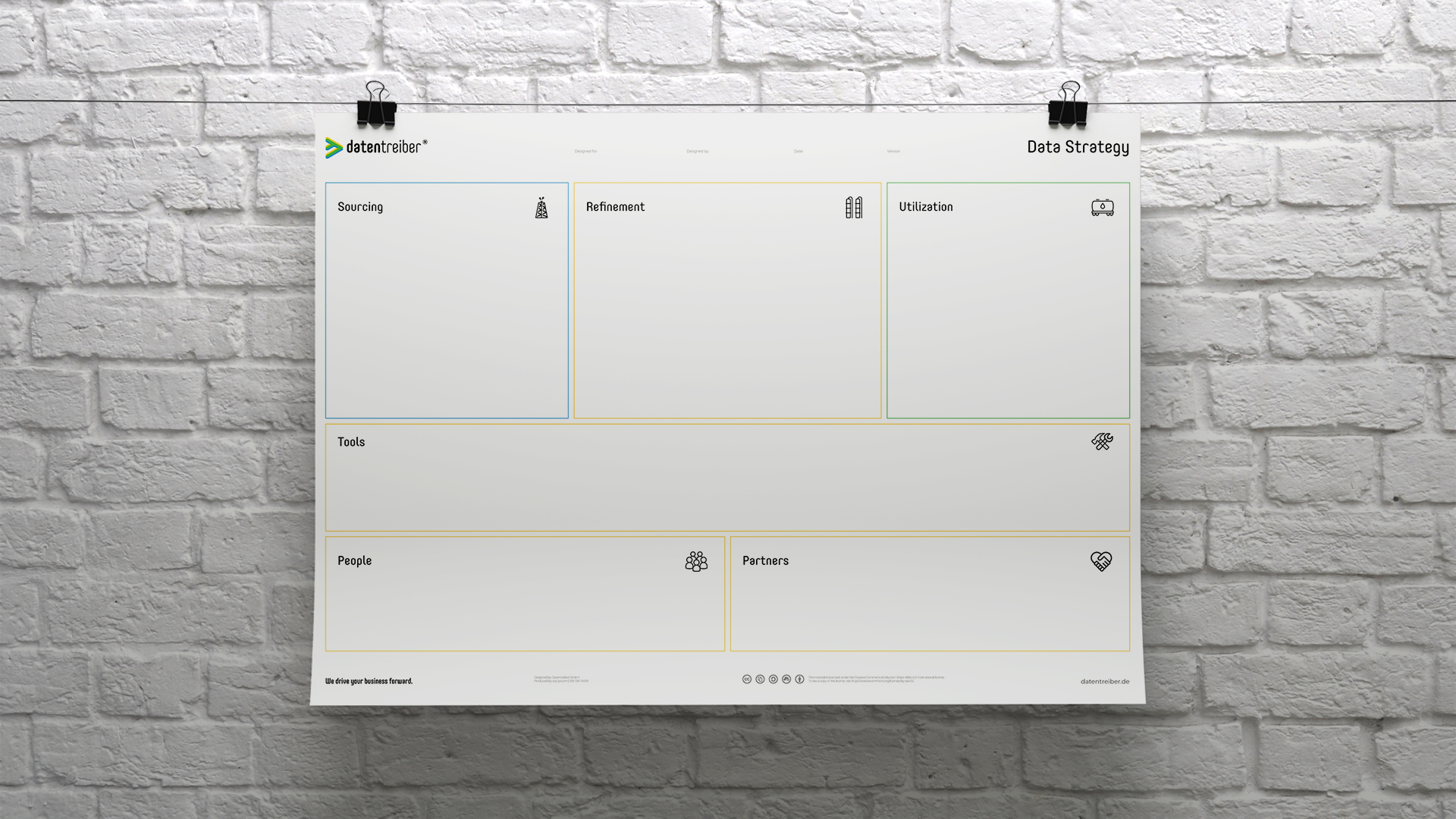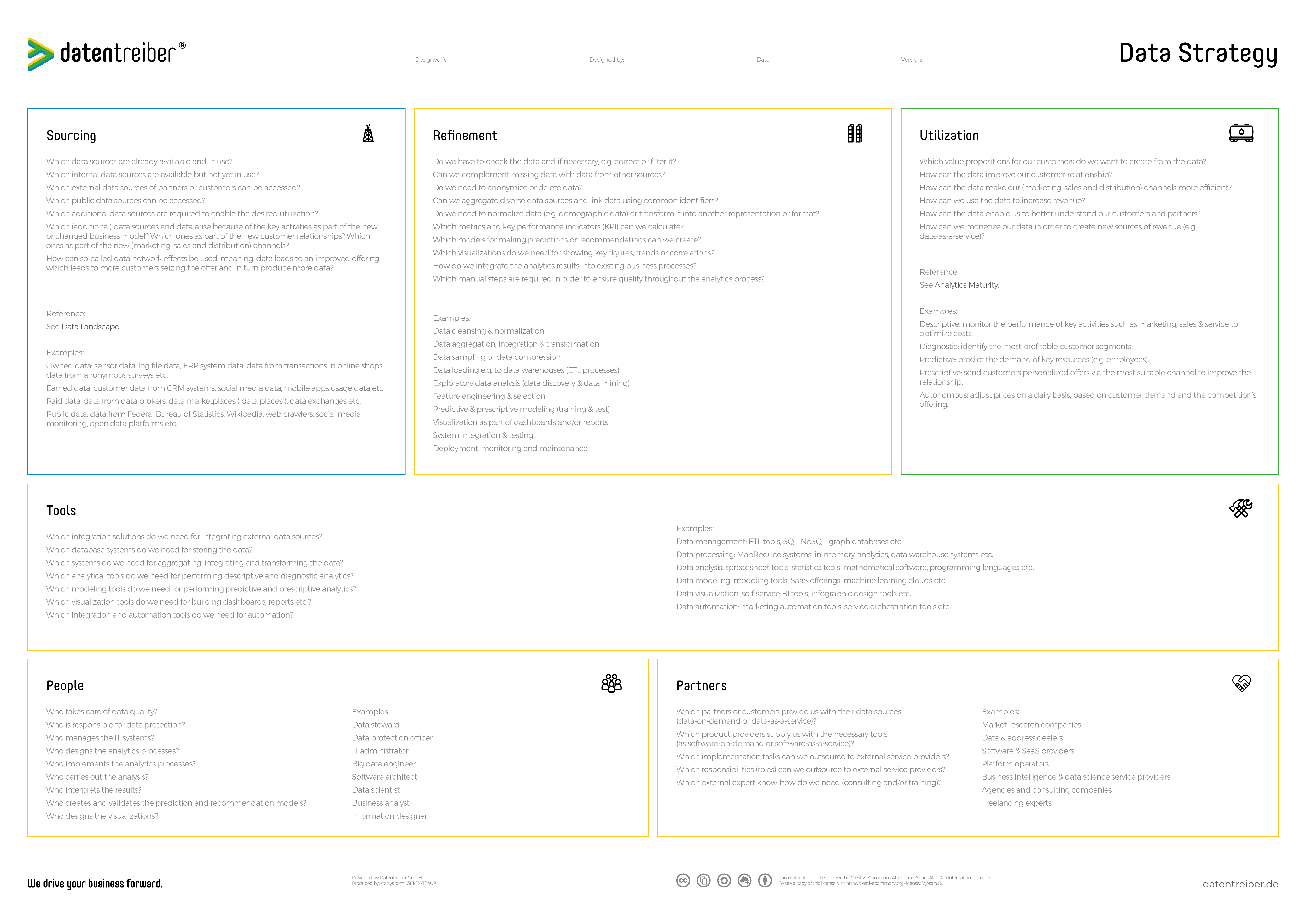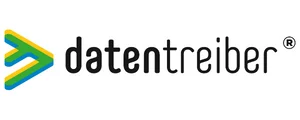
Data Strategy Canvas
Using the Data Strategy Canvas you can concretize and evaluate utilization strategies for your corporate data. The visual collaboration tool helps you to develop analytical applications in interdisciplinary teams, to identify critical questions regarding the feasibility as well as to derive the resources required for the realization (data, tools, employees etc.).
We drive your business forward.
What Is the Data Strategy Canvas?
The Data Strategy Canvas is a central tool within the Data Strategy Design method. It helps you to answer the three critical questions of a data strategy:
- Utilization: why do we need a data strategy? – Hence: which corporate targets do you want to achieve by utilizing the data?
- Refinement: how does our data strategy look like? – As soon as you know the target, you need to define the path towards it: how can you refine the data to valuable information?
- (Data) Sourcing: which data do we need for this? – Next you think of the data already available to you and which additional data sources you can tap.
Furthermore, the Data Strategy Canvas enables you to derive the resources required to realize the data strategy:
- Tools: which analytical tools, database systems, programming languages etc. are required to source, refine and utilize the data?
- People: who uses these tools and has the required skills and knowledge?
- Partners: which partners do provide us with data, tools or staff?
The Data Strategy Canvas is available for free under a Creative Commons license: you may use and modify the canvas as long as you cite Datentreiber in particular as the source.
We drive your business forward.

We drive your business forward.
How Do I Use the Data Strategy Canvas?
A data strategy answers critical questions for a data-driven company:
- Sourcing: Which data sources are available and how do we use them?
- Refinement: How can we combine and prepare data to gain valuable insights?
- Utilization: How can we use the insights to reduce costs, increase sales, retain customers and develop new products and business models?
- Tools: Which software solutions, databases, technical infrastructure, etc. do we need?
- People: Which skills and experts do we need in the company?
- Partners: Which partner companies are required?
For more information, see Data Strategy Design.
Start
You can either start with the available data sources (Sourcing) or the possible applications (Utilization). Your starting point depends on whether you want to identify new applications based on existing data sources or specify necessary data sources for a specific application. You then cycle through the individual boxes from the left to the right (or vice versa) and from the top to the bottom. While doing this you answer the following as well as further relevant questions.
Step 1 of 6
Sourcing
Like any raw material, data must be first sourced before it can be refined and eventually utilized. Data collection is usually preceded by an exploration, in which the potential data sources are identified and evaluated. In fact, only those data sources should be tapped whose data are subsequently utilized.
Questions:
- Which data sources are already available and in use?
- Which internal data sources are available but not yet in use?
- Which external data sources of partners or customers can be accessed?
- Which public data sources can be accessed?
- Which additional data sources are required to enable the desired utilization?
- Which (additional) data sources and data arise because of the key activities as part of the new or changed business model? Which ones as part of the new customer relationships? Which ones as part of the new (marketing, sales and distribution) channels?
- How can so-called data network effects be used, meaning, data leads to an improved offering, which leads to more customers seizing the offer and in turn produce more data?
Step 1 of 6
Colors:
- Green cards for data sources that are already available and in use, e.g., CRM data
- Yellow cards for data sources that are available but not yet used, e.g., external firmographics data.
- Red cards for data sources which are necessary to realize an use case (see utilization) but are neither present nor in use.
Examples:
- Owned data: sensor data, log file data, ERP system data, data from transactions in online shops, data from anonymous surveys, etc.
- Earned data: customer data from CRM systems, social media data, mobile apps usage data, etc.
- Paid data: data from data brokers, data marketplaces (“data places”), data exchanges, etc.
- Public data: data from Federal Bureau of Statistics, Wikipedia, web crawlers, social media monitoring, open data platforms, etc.
References:
- Business Model / Case: data are a resource of data-driven companies.
- Data Landscape: to explore the data landscape of a company in detail.
Step 2 of 6
Refinement
Data are the oil of the 21st century. Just as oil must be refined into petrol or diesel to drive an engine as fuel, data must be refined to extract insights that fuel data-driven decisions, processes, and business models in companies. Data analytics takes care of data refinement.
Questions:
- Do we have to check the data and if necessary, e.g., correct or filter it?
- Can we complement missing data with data from other sources?
- Do we need to anonymize or delete data?
- Can we aggregate diverse data sources and link data using common identifiers?
- Do we need to normalize data (e.g. demographic data) or transform it into another representation or format?
- Which metrics and key performance indicators (KPI) can we calculate?
- Which models for making predictions or recommendations can we create?
- Which visualizations do we need for showing key figures, trends or correlations?
- How do we integrate the analytics results into existing business processes?
- Which manual steps are required in order to ensure quality throughout the analytics process?
Step 2 of 6
Colors:
- Green cards for processing steps already implemented.
- Yellow cards for processing steps that are in progress.
- Red cards for processing steps that are still to be implemented.
Examples:
- Data cleansing & normalization
- Data aggregation, integration & transformation
- Data sampling or data compression
- Data loading e.g. to data warehouses (ETL processes)
- Exploratory data analysis (data discovery & data mining)
- Feature engineering & selection
- Predictive & prescriptive modeling (training & test)
- Visualization as part of dashboards and/or reports
- System integration & testing
- Deployment, monitoring and maintenance
References:
- Business Model / Case: the process of refining the data is an activity of the business model.
- Analytics Maturity: the methods used determine the necessary degree of analytical maturity of the company or the customer.
Step 3 of 6
Utilization
After the raw material data has been refined into the fuel information, the information must be utilized. The gained insights are for example used to make more reliable decisions.
Questions:
- Which value propositions for our customers do we want to create from the data?
- How can the data improve our customer relationship?
- How can the data make our (marketing, sales and distribution) channels more efficient?
- How do the data help us to make our key activities, the use of the key resources and the costs more efficient?
- How can we use the data to increase revenue?
- How can the data enable us to better understand our customers and partners?
- How can we monetize our data in order to create new sources of revenue (e.g. data-as-a-service)?
Step 3 of 6
Colors:
- Green cards for applications with high implementation probability.
- Yellow cards for applications with unclear feasibility.
- Red cards for applications where critical parts, e.g. data sources, are missing.
Examples:
- Descriptive: monitor the performance of key activities such as marketing, sales & service to optimize costs.
- Diagnostic: identify the most profitable customer segments.
- Predictive: predict the demand of key resources (e.g. employees).
- Prescriptive: send customers personalized offers via the most suitable channel to improve the relationship.
- Autonomous: adjust prices on a daily basis, based on customer demand and the competition’s offering.
References:
- Analytics Use Case: to create value propositions for customers, partners, or employees. (German version, coming soon in English)
- Business Model / Case: to identify possible fields of application.
- Analytics Maturity: to prioritize various possibilities of development regarding the necessary analytical maturity of the company or the customer.
Step 4 of 6
Tools
The sourcing, refinement, and utilization of data require specialized tools, which vary greatly depending on the data source, data volume, data format, purpose of analysis, surrounding conditions, or application. Accordingly, the question regarding the necessary tools should be only asked after it is clear which data should be sourced, refined, and utilized, in which way and for what purpose.
Questions:
- Which integration solutions do we need for integrating external data sources?
- Which database systems do we need for storing the data?
- Which systems do we need for aggregating, integrating and transforming the data?
- Which analytical tools do we need for performing descriptive and diagnostic analytics?
- Which modeling tools do we need for performing predictive and prescriptive analytics?
- Which visualization tools do we need for building dashboards, reports etc.?
- Which integration and automation tools do we need for automation?
Step 4 of 6
Colors:
- Green cards for tools already available.
- Yellow cards for tools whose availability is not yet clear.
- Red cards for tools that are still missing.
Examples:
- Data Management: ETL tools, SQL, NoSQL, graph databases etc.
- Data processing: MapReduce systems, in-memory-analytics, data warehouse systems etc.
- Data analysis: spreadsheet tools, statistics tools, mathematical software, programming languages etc.
- Data modeling: modeling tools, SaaS offerings, machine learning clouds etc.
- Data visualization: self-service BI tools, infographic design tools etc.
- Data automation: marketing automation tools, service orchestration tools etc.
References:
- Business Model / Case: tools are a key resource for data-driven companies.
Step 5 of 6
People
In order to use the specialized tools, specialists in the company need to know how the tools are operated, configured, and administered. Instead of thinking about concrete persons, you can also think about roles and consider whether a person should fill several roles or if a role needs to be fulfilled several times in the company (for example because of availability).
Questions:
- Who takes care of data quality?
- Who is responsible for data protection?
- Who manages the IT systems?
- Who designs the analytics processes?
- Who implements the analytics processes?
- Who carries out the analysis?
- Who interprets the results?
- Who creates and validates the prediction and recommendation models?
- Who designs the visualizations?
Step 5 of 6
Colors:
- Green cards, if the role, ability or expert is already present in the company.
- Yellow cards when the availability still needs to be clarified.
- Red cards, if the role, ability or expert is missing in the company.
Examples:
- Data steward
- Data protection officer
- IT administrator
- Big data engineer
- Software architect
- Data scientist
- Business analyst
- Information designer
References:
- Business Model / Case: (data) experts are a key resource for data-driven companies.
Step 6 of 6
Partners
Maybe certain roles cannot or may not be fulfilled internally because, for example, the concerned employee would not be needed full-time. In this case, you need a specialized partner who is available as a service provider for you. Partners might be also companies that provide you with critical data or tools that you simply could not obtain otherwise.
Questions:
- Which partners or customers provide us with their data sources (data-on-demand or data-as-a-service)?
- Which product providers supply us with the necessary tools (as software-on-demand or software-as-a-service)?
- Which implementation tasks can we outsource to external service providers?
- Which responsibilities (roles) can we outsource to external service providers?
- Which external expert know-how do we need (consulting and/ or training)?
Step 6 of 6
Colors:
- Green cards for companies that are already partners.
- Yellow cards for companies whose the status is unclear or in negotiation.
- Red cards for companies that are not yet partners.
Examples:
- Market research companies
- Data & address dealers
- Software & SaaS providers
- Platform operators
- Business Intelligence & data science service providers
- Agencies & consulting companies
- Freelancing experts
References:
- Business Model / Case: partners that provide data, tools or personnel as part of a data strategy are among the partnerships.
Completion
When you have finished all boxes, check your data strategy for consistency and completeness. If necessary, let the work pause for a day and/or present your data strategy to colleagues who were not involved in the development. Try to tell a story and pay attention to logical breaks and inconsistencies.
For example, consider the following questions:
- Do I have the corresponding link data to join the different data sources?
- Do I have the right tools to tap the data sources?
- Do I have the staff to use the tools?
- etc.
Highlight open questions, critical assumptions, or potential weak spots with white cards and define tasks to answer these questions, test assumptions, and examine weaknesses. If necessary, rework your data strategy if, for example, a critical assumption has proven to be wrong.
Finally, you can integrate the building blocks of your data strategy into your Business Model / Case. If you have identified more than one utilization opportunity, use the template Analytics Maturity, to compare and prioritize them.
We drive your business forward.
Where Can I Find More Information?
The presentation referred to beside introduces you to the Data Strategy Design method and Data Strategy Canvas by means of an example project.
Here you can find further documentation:
Mit einer Datenstrategie gegen Ihren Informationsdurst (Blog)
Why you need a Data Strategy (Press Article)
Using Data Strategy Design to Build Data-Driven Products (SlideShare)
Data Thinker-Gruppe (LinkedIn)
We drive your business forward.
How Can I Start?
Seminars

Get to know our Data Strategy Design Method in our practical seminars:
- For beginners: Data Strategy & Culture
- For rising stars: Data Design Thinking
- For advanced designers: Data Business Consulting
Cross References

Here you can find further canvas and information concerning Data Strategy Design:
License Terms

You are free to:
Share — copy and redistribute the canvas in any medium or format
Adapt — remix, transform, and build upon the canvas
for any purpose, even commercially.
Under the following terms:
Attribution
ShareAlike
We drive your business forward.
Subscribe to our newsletter:
Receive all relevant blog articles, new seminar dates, special conference offers and much more conveniently by email. As a welcome gift, we will send you a link to download our Datentreiber design book (in German) and, for a short time, the article ” Data Thinking: mehr Wert aus Daten” in PDF form after your registration.
By clicking ‘Subscribe to our newsletter’ you agree that we process your information in accordance with our privacy policy.


